Mapping nucleolus-associated chromatin interactions using nucleolus Hi-C reveals pattern of heterochromatin interactions
- PMID: 36681699
- PMCID: PMC9867699
- DOI: 10.1038/s41467-023-36021-1
Mapping nucleolus-associated chromatin interactions using nucleolus Hi-C reveals pattern of heterochromatin interactions
Abstract
As the largest substructures in the nucleus, nucleoli are the sites of ribosome biogenesis. Increasing evidence indicates that nucleoli play a key role in the organization of 3D genome architecture, but systematic studies of nucleolus-associated chromatin interactions are lacking. Here, we developed a nucleolus Hi-C (nHi-C) experimental technique to enrich nucleolus-associated chromatin interactions. Using the nHi-C experiment, we identify 264 high-confidence nucleolus-associated domains (hNADs) that form strong heterochromatin interactions associated with the nucleolus and consist of 24% of the whole genome in HeLa cells. Based on the global hNAD inter-chromosomal interactions, we find five nucleolar organizer region (NOR)-bearing chromosomes formed into two clusters that show different interaction patterns, which is concordant with their epigenetic states and gene expression levels. hNADs can be divided into three groups that display distinct cis/trans interaction signals, interaction frequencies associated with nucleoli, distance from the centromeres, and overlap percentage with lamina-associated domains (LADs). Nucleolus disassembly caused by Actinomycin D (ActD) significantly decreases the strength of hNADs and affects compartment/TAD strength genome-wide. In summary, our results provide a global view of heterochromatin interactions organized around nucleoli and demonstrate that nucleoli act as an inactive inter-chromosomal hub to shape both compartments and TADs.
© 2023. The Author(s).
Conflict of interest statement
The authors declare no competing interests.
Figures
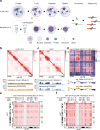

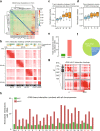

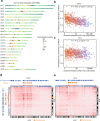
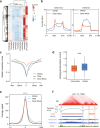

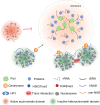
Similar articles
-
Emerging roles for the nucleolus in development and stem cells.Development. 2025 May 1;152(9):dev204696. doi: 10.1242/dev.204696. Epub 2025 May 14. Development. 2025. PMID: 40366093 Free PMC article. Review.
-
Genome Organization in and around the Nucleolus.Cells. 2019 Jun 12;8(6):579. doi: 10.3390/cells8060579. Cells. 2019. PMID: 31212844 Free PMC article. Review.
-
Identification of Nucleolus-Associated Chromatin Domains Reveals a Role for the Nucleolus in 3D Organization of the A. thaliana Genome.Cell Rep. 2016 Aug 9;16(6):1574-1587. doi: 10.1016/j.celrep.2016.07.016. Epub 2016 Jul 28. Cell Rep. 2016. PMID: 27477271 Free PMC article.
-
Loss of nucleolar histone chaperone NPM1 triggers rearrangement of heterochromatin and synergizes with a deficiency in DNA methyltransferase DNMT3A to drive ribosomal DNA transcription.J Biol Chem. 2014 Dec 12;289(50):34601-19. doi: 10.1074/jbc.M114.569244. Epub 2014 Oct 27. J Biol Chem. 2014. PMID: 25349213 Free PMC article.
-
Genome-wide maps of nucleolus interactions reveal distinct layers of repressive chromatin domains.Nat Commun. 2022 Mar 18;13(1):1483. doi: 10.1038/s41467-022-29146-2. Nat Commun. 2022. PMID: 35304483 Free PMC article.
Cited by
-
Emerging roles for the nucleolus in development and stem cells.Development. 2025 May 1;152(9):dev204696. doi: 10.1242/dev.204696. Epub 2025 May 14. Development. 2025. PMID: 40366093 Free PMC article. Review.
-
Clusters of lineage-specific genes are anchored by ZNF274 in repressive perinucleolar compartments.Sci Adv. 2024 Sep 13;10(37):eado1662. doi: 10.1126/sciadv.ado1662. Epub 2024 Sep 13. Sci Adv. 2024. PMID: 39270011 Free PMC article.
-
Stress-Induced Evolution of the Nucleolus: The Role of Ribosomal Intergenic Spacer (rIGS) Transcripts.Biomolecules. 2024 Oct 20;14(10):1333. doi: 10.3390/biom14101333. Biomolecules. 2024. PMID: 39456266 Free PMC article. Review.
-
Arabidopsis ASYMMETRIC LEAVES2 and Nucleolar Factors Are Coordinately Involved in the Perinucleolar Patterning of AS2 Bodies and Leaf Development.Plants (Basel). 2023 Oct 19;12(20):3621. doi: 10.3390/plants12203621. Plants (Basel). 2023. PMID: 37896084 Free PMC article.
-
Essential roles of the nucleolus during early embryonic development: a regulatory hub for chromatin organization.Open Biol. 2024 May;14(5):230358. doi: 10.1098/rsob.230358. Epub 2024 May 1. Open Biol. 2024. PMID: 38689555 Free PMC article.
References
Publication types
MeSH terms
Substances
LinkOut - more resources
Full Text Sources
Molecular Biology Databases
Research Materials

